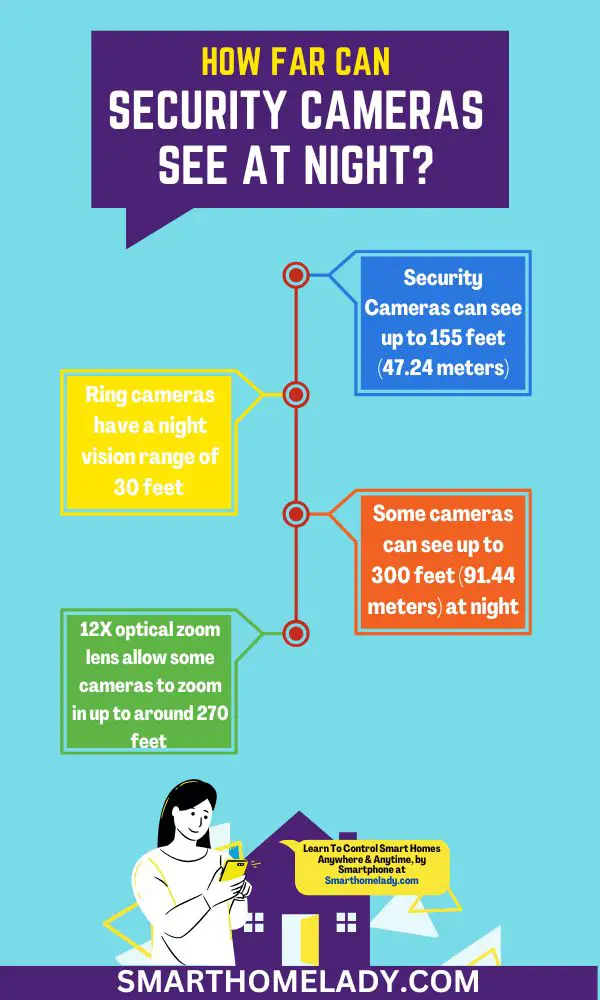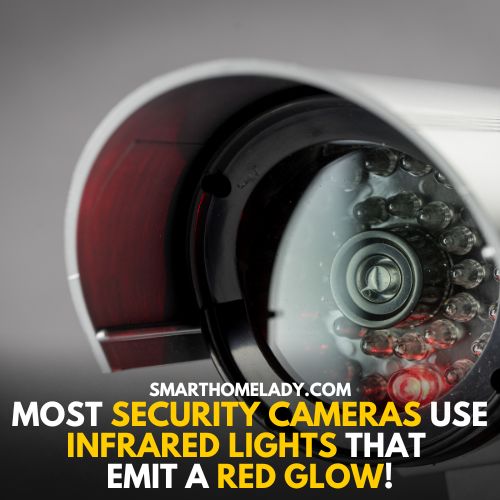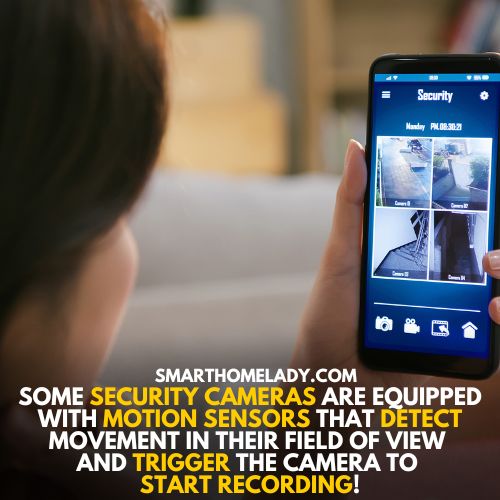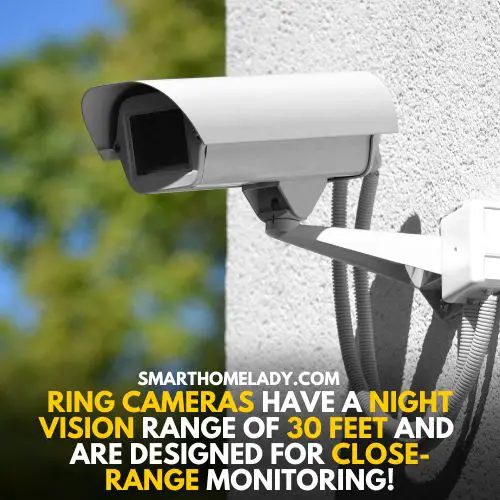Have you ever wondered how far can security cameras see at night? As technology continues to advance, security cameras have become a crucial tool for monitoring and protecting homes, businesses, and public spaces.
But how effective are they when it comes to capturing clear images in low-light conditions? The answer to this question largely depends on the security camera used.
In this article, we’ll explore the different types of security cameras available, how far they work in low-light conditions, and what factors can impact their night vision capabilities.
So, if you’re curious about how far security cameras can see at night, read on to find out.

Contents
- 1 How Far Can security cameras see at Night? 30 – 300 feet
- 2 How Do Security Cameras See At Night?
- 3 Factor That Affects How Far Can Security Cameras At Night
- 4 How far can ring camera see at night?
- 5 How Far Can A Camera See?
- 6 How Good Are Security Cameras At Night?
- 7 How far does Ring detect motion at night?
- 8 How far can home security cameras see at night?
- 9 How Far Can Outdoor Security Cameras See At Night?
- 10 Conclusion
How Far Can security cameras see at Night? 30 – 300 feet
Did you know that security cameras have a superpower? Well, sort of. They have night vision capabilities that allow them to see up to 155 feet (47.24 meters) in the dark. That’s pretty impressive, Don’t you think?
For example, if you have a security camera installed in your front yard, it may be able to detect people walking around in the street or your neighbor’s driveway up to 155 meters away.
This should be enough to cover most residential and commercial properties, but if you have a larger area to monitor, you may need to invest in cameras with a longer range.
In fact, some cameras can see up to 300 feet (91.44 meters) at night, which is more than enough for most applications. However, if you need even more coverage, cameras can see up to 492 feet (150 meters) in complete darkness.
Of course, the range of a security camera’s night vision capabilities will depend on a few factors, such as the quality of the camera’s optics and the ambient lighting conditions.
A good rule of thumb is to look for cameras that can see at least 30 feet away in low-light conditions. Security cameras with a night-vision capability of 90 feet are also available.
If you really want to maximize your night vision capabilities, consider investing in a camera with an integrated zoom lens. Few cameras have a 12X optical zoom lens that allows them to zoom in up to around 270 feet away,
How Do Security Cameras See At Night?
Security cameras have revolutionized the way we keep our homes and businesses safe. But how do these cameras see at night when little to no light is available?
The answer lies in the following features that make these cameras capable of capturing clear footage in the dark.
1. Infrared Lights
Infrared lights are a game changer when it comes to security cameras. These powerful lights emit a spectrum of light invisible to the human eye but visible to cameras.
It means that security cameras with infrared lights can capture clear, detailed images even in complete darkness.
One interesting thing to note is that not all infrared lights are created equal – they come in different colors.
Most security cameras use infrared lights that emit a red glow, but some cameras use lights that emit a blue or green glow. This may seem like a minor detail, but it can make a big difference in the images’ quality.

Infrared technology is widely used in security cameras and is particularly effective in low-light conditions.
How do Infrared Lights In Security Cameras Work?
So, how do these infrared lights work to give security cameras the ability to see at night?
The camera automatically switches to infrared mode when it detects low light or darkness. The infrared lights turn on and flood the area with invisible light.
The camera’s image sensor picks up this light and converts it into an image that can be seen on the monitor or recording device.
The result is a feature known as night vision, which is essential for any security camera system. It allows you to monitor your property 24/7, even in the darkest conditions.
Whether you’re protecting your home, business, or any other property, infrared lights are a must-have for any security camera system.
Read More
- Lights On Security Cameras And Their Meaning
- What Is Sleep Delay On Security Cameras?
- Why Do Security Cameras Have Bad Quality?
- Can You Put Security Camera On Trees?
2. Thermal Imaging
Using thermal imaging sensors, security cameras can now see in complete darkness. This technology works by detecting the heat signatures of objects and people, which are then translated into visible images.
Unlike traditional night-vision cameras that rely on infrared light, thermal imaging cameras can easily see through smoke, fog, and darkness.
It makes them an ideal solution for security applications where visibility is crucial, such as in low-light conditions or areas with limited lighting.
Thermal imaging cameras work by using a special lens that focuses the heat signatures of objects onto a sensor. This sensor then converts the heat signatures into a visual image that can be displayed on a monitor.
The images produced by thermal cameras are typically grayscale, with hotter objects appearing as brighter shades of white and cooler things appearing as darker shades of gray.
Most modern security cameras use a combination of infrared lights and thermal imaging to capture clear images in low-light conditions. Some cameras also come equipped with a feature called “night vision,” which combines infrared and visible light to create a clear image in the dark.
3. Motion Sensors
In addition to these technologies, some security cameras are equipped with motion sensors. These sensors detect movement in their field of view and trigger the camera to start recording, even in complete darkness.

This feature is particularly useful for outdoor security cameras that must capture footage of intruders or animals moving around at night.
Whether you’re looking to secure your home or business, investing in a high-quality security camera with these features can help you rest easy knowing that your property is protected around the clock.
Factor That Affects How Far Can Security Cameras At Night
Security cameras are one of the most effective tools for monitoring your property and keeping it safe from theft and vandalism. However, not all security cameras are created equal, and some are better equipped than others to capture clear images in low-light conditions.
Here are some of the key factors that affect how far security cameras can see at night:
1. Focal Length
The focal length of a security camera’s lens is a critical factor in determining its range and clarity at night. Cameras with longer focal lengths can zoom in on objects at greater distances, making them ideal for monitoring large outdoor areas.
However, longer focal lengths also mean narrower fields of view, so you’ll need to choose your camera placement carefully to cover all the areas you want to monitor.
2. Resolution
The resolution of a security camera is another important factor that affects its performance at night.
High-resolution cameras can capture more detail and produce clearer images, even in low-light conditions.
However, higher-resolution cameras also require more storage space and processing power, so you’ll need to choose a camera that balances resolution with practicality.
3. Placement of Cameras
The placement of your security cameras can also have a significant impact on their performance at night. Cameras that are placed too close to bright lights or other sources of glare may produce washed-out images or false alarms.
Conversely, cameras that are placed too far away from the areas you want to monitor may not capture enough detail to be useful.
Careful placement of cameras is key to ensuring that you get the best possible performance from your security system.
4. Camera Quality and Design
The quality and design of your security cameras can also affect their performance at night. Cameras that are designed specifically for low-light conditions, such as infrared cameras, can produce clearer images and capture more detail than standard cameras.
Additionally, cameras with high-quality lenses and sensors are more likely to produce clear images, even in challenging lighting conditions.
Tip: When choosing a security camera, consider the features and specifications most important to you and your specific security needs.
5. Environment
The environment also impacts the range of a security camera’s vision at night. For example, if the area is foggy or smoky, the visibility will be reduced.
Additionally, if the camera faces away from the light source, such as the moon, its vision will also be reduced.
Read More
- Why Do Security Cameras Lag?
- Why Is My Security Camera Blurry?
- What Causes Ghost Images On Security Cameras?
How far can ring camera see at night?
The range of a Ring camera is slightly different. Ring cameras have a night vision range of 30 feet and are designed for close-range monitoring.
Whether you’re trying to monitor your front door, back yard, or driveway, the Ring camera’s night vision feature ensures you can see any potential threats, no matter how dark it is outside.

However, it’s important to note that the Ring camera’s night vision range can be affected by various factors, such as the ambient light level, the distance between the camera and the object being monitored, and any obstacles in the camera’s line of sight.
Nevertheless, with a range of up to 30 feet, the Ring camera is an excellent choice for anyone looking to enhance their home security by keeping an eye on their property at night.
Frequently Asked Questions FAQs
How Far Can A Camera See?
Generally, most cameras can see between 30 and 100 feet away in low-light conditions. A camera’s field of view is determined by its lens, so the exact distance a camera can see will vary depending on the model.
How Good Are Security Cameras At Night?
Security cameras with night vision can detect motion up to 30-100 feet away, depending on the model and its environment.
For instance, a low-end model may detect motion up to 30 feet away, while a high-end model may detect motion up to 100 feet away.
How far does Ring detect motion at night?
Ring’s motion detection technology is designed to detect motion up to 30 feet away in the dark, although this can vary depending on the specific environment.
Ring also offers customizable motion settings and a Night Vision mode, allowing users to adjust the motion sensitivity and range according to their needs. This ensures that users can maximize their security system’s effectiveness and minimize false alarms.
How far can home security cameras see at night?
Home security cameras typically have a shorter range than professional security cameras, but they can still see quite far. The range for home security cameras can vary from 100ft to 200ft, depending on the type of camera and the lighting conditions.
For example, a high-quality home security camera with infrared technology can capture images in the dark with clear clarity, while a standard camera may only be able to capture images up to 30ft away.
How Far Can Outdoor Security Cameras See At Night?
Outdoor security cameras need a night vision range of at least 40 feet to provide optimal security, whereas indoor cameras need a night vision range of up to 20 feet.
Conclusion
In conclusion, security cameras can see up to a distance of at least 100ft in the dark, depending on your camera type. They can also be used with infrared lighting to extend the viewing range.
Security cameras offer a great way to deter crime, protect property and monitor what is going on in your home or business. I hope this article has been helpful in providing you with the information you need to make an informed decision about your security camera system.
I would love to hear your thoughts and experiences on security cameras and night vision. Please feel free to leave a comment below and let me know what you think.


